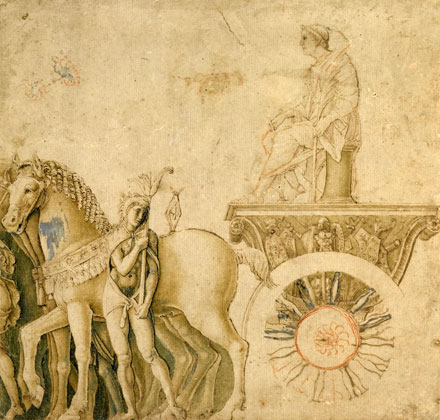The Triumphs of Caesar
Mantegna's reputation was largely founded on the cycle of the Triumphs of Caesar, copied or engraved very early on, provoking the admiration of Correggio, Rubens, Poussin or Goethe. The nine painted canvases were acquired by Charles I of England at the end of the 1620s and have been displayed in Hampton Court Palace since 1630.
This grandiose undertaking certainly kept Mantegna busy until the end of his days, but we ignore when it was started—nonetheless in 1486, some of them were admired by the young Duke of Urbino—we also ignore why and by whom this impressive military parade was commissioned (Marchese Federico or Francesco who succeeded to the title in 1484).
Triumphal imagery was omnipresent in the Veneto, as can be seen in certain manuscripts, nonetheless this exemplary visual reconstruction of a major episode in Ancient History is, above all, the fruit of Mantegna's own epic imagination.
The Triumphs illustrate personages of all ages and kinds (soldiers, buglers, prisoners, domestic animals and exotic beasts) and the most varied objects (trophies, weapons, insignia, flags…). A whole world passes by, full life-size, seen from below as if walking on a stage.
after Mantegna
Julius Caesar on His Triumphal Chariot
Pen and brown ink; H. 26.2 cm; W. 27.3 cm
London, British Museum. Dept. Prints & Drawings, inv. 1895-9-15-773
© The Trustees of the British Museum





